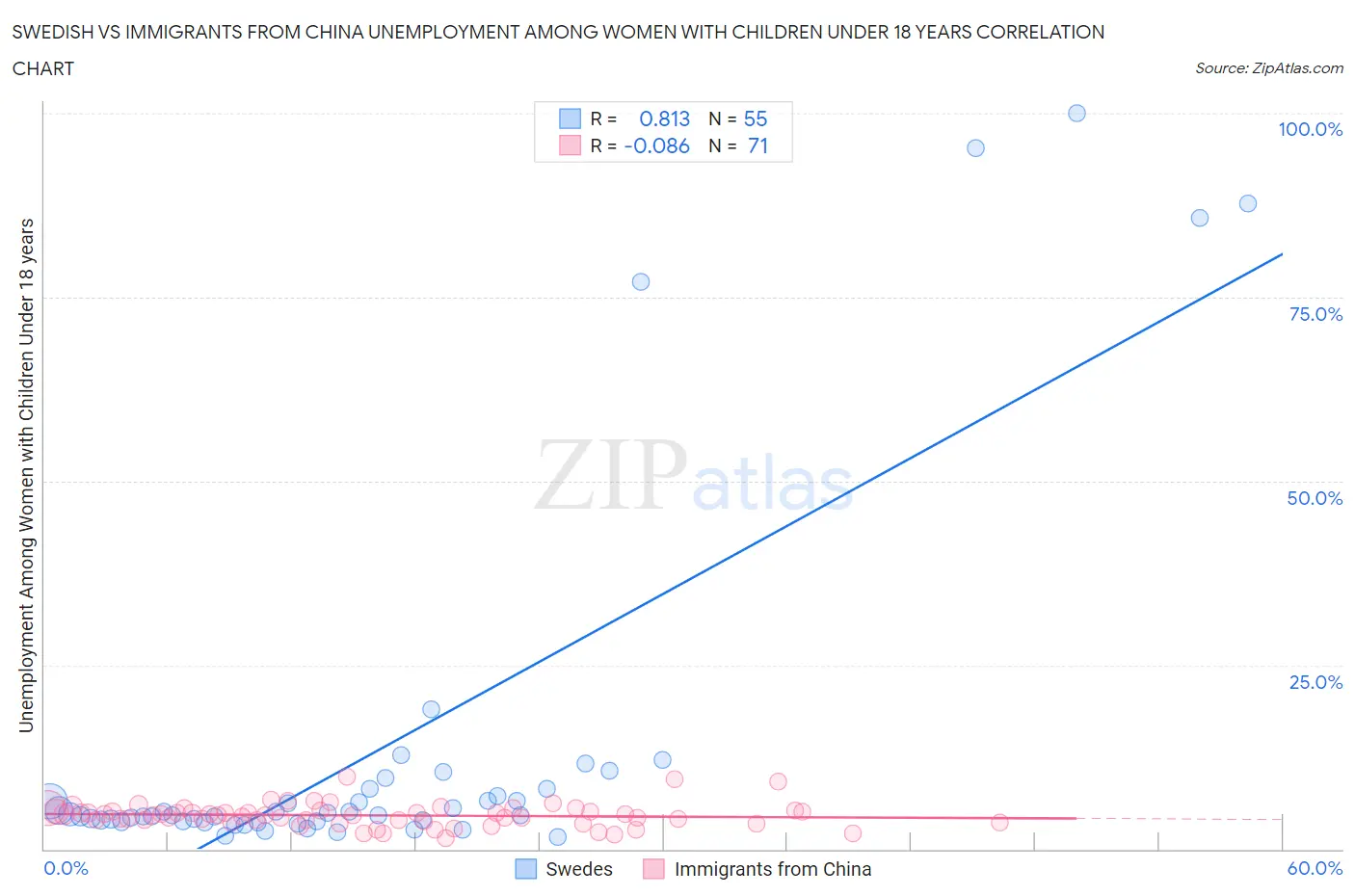Swedish vs Immigrants from China Unemployment Among Women with Children Under 18 years
COMPARE
Swedish
Immigrants from China
Unemployment Among Women with Children Under 18 years
Unemployment Among Women with Children Under 18 years Comparison
Swedes
Immigrants from China
4.7%
UNEMPLOYMENT AMONG WOMEN WITH CHILDREN UNDER 18 YEARS
100.0/ 100
METRIC RATING
4th/ 347
METRIC RANK
4.9%
UNEMPLOYMENT AMONG WOMEN WITH CHILDREN UNDER 18 YEARS
99.6/ 100
METRIC RATING
23rd/ 347
METRIC RANK
Swedish vs Immigrants from China Unemployment Among Women with Children Under 18 years Correlation Chart
The statistical analysis conducted on geographies consisting of 492,150,617 people shows a very strong positive correlation between the proportion of Swedes and unemployment rate among women with children under the age of 18 in the United States with a correlation coefficient (R) of 0.813 and weighted average of 4.7%. Similarly, the statistical analysis conducted on geographies consisting of 434,778,409 people shows a slight negative correlation between the proportion of Immigrants from China and unemployment rate among women with children under the age of 18 in the United States with a correlation coefficient (R) of -0.086 and weighted average of 4.9%, a difference of 5.6%.

Unemployment Among Women with Children Under 18 years Correlation Summary
| Measurement | Swedish | Immigrants from China |
| Minimum | 1.6% | 1.5% |
| Maximum | 100.0% | 9.8% |
| Range | 98.4% | 8.3% |
| Mean | 13.2% | 4.6% |
| Median | 4.7% | 4.6% |
| Interquartile 25% (IQ1) | 3.8% | 3.7% |
| Interquartile 75% (IQ3) | 8.1% | 5.1% |
| Interquartile Range (IQR) | 4.3% | 1.4% |
| Standard Deviation (Sample) | 24.6% | 1.6% |
| Standard Deviation (Population) | 24.3% | 1.6% |
Demographics Similar to Swedes and Immigrants from China by Unemployment Among Women with Children Under 18 years
In terms of unemployment among women with children under 18 years, the demographic groups most similar to Swedes are Tongan (4.7%, a difference of 0.050%), Immigrants from Taiwan (4.7%, a difference of 0.16%), Immigrants from India (4.7%, a difference of 0.27%), Immigrants from Hong Kong (4.7%, a difference of 0.69%), and Okinawan (4.7%, a difference of 1.5%). Similarly, the demographic groups most similar to Immigrants from China are Indian (Asian) (4.9%, a difference of 0.20%), European (4.9%, a difference of 0.40%), Latvian (4.9%, a difference of 1.0%), German (4.9%, a difference of 1.1%), and Slovene (4.9%, a difference of 1.3%).
| Demographics | Rating | Rank | Unemployment Among Women with Children Under 18 years |
| Danes | 100.0 /100 | #3 | Exceptional 4.5% |
| Swedes | 100.0 /100 | #4 | Exceptional 4.7% |
| Tongans | 100.0 /100 | #5 | Exceptional 4.7% |
| Immigrants | Taiwan | 100.0 /100 | #6 | Exceptional 4.7% |
| Immigrants | India | 100.0 /100 | #7 | Exceptional 4.7% |
| Immigrants | Hong Kong | 100.0 /100 | #8 | Exceptional 4.7% |
| Okinawans | 99.9 /100 | #9 | Exceptional 4.7% |
| Czechs | 99.9 /100 | #10 | Exceptional 4.7% |
| Filipinos | 99.9 /100 | #11 | Exceptional 4.8% |
| Scandinavians | 99.9 /100 | #12 | Exceptional 4.8% |
| Bulgarians | 99.9 /100 | #13 | Exceptional 4.8% |
| Cambodians | 99.9 /100 | #14 | Exceptional 4.8% |
| Thais | 99.8 /100 | #15 | Exceptional 4.8% |
| Taiwanese | 99.8 /100 | #16 | Exceptional 4.8% |
| Immigrants | Singapore | 99.8 /100 | #17 | Exceptional 4.9% |
| Slovenes | 99.8 /100 | #18 | Exceptional 4.9% |
| Germans | 99.8 /100 | #19 | Exceptional 4.9% |
| Latvians | 99.7 /100 | #20 | Exceptional 4.9% |
| Europeans | 99.6 /100 | #21 | Exceptional 4.9% |
| Indians (Asian) | 99.6 /100 | #22 | Exceptional 4.9% |
| Immigrants | China | 99.6 /100 | #23 | Exceptional 4.9% |